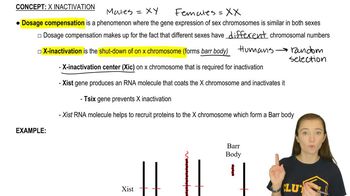Here are the essential concepts you must grasp in order to answer the question correctly.
Double Helix Structure
The double helix is the three-dimensional structure of DNA, consisting of two intertwined strands that form a spiral shape. This model, proposed by Watson and Crick in 1953, illustrates how the sugar-phosphate backbone of each strand runs in opposite directions, allowing for complementary base pairing between adenine-thymine and guanine-cytosine. Understanding this structure is crucial for grasping how genetic information is stored and replicated.
Recommended video:
X-ray Crystallography
X-ray crystallography is a technique used to determine the atomic and molecular structure of a crystal by diffracting X-ray beams through it. Rosalind Franklin's X-ray diffraction images of DNA provided critical evidence of its helical structure, which was pivotal for Watson and Crick's model. This method allowed them to visualize the dimensions and arrangement of the DNA molecule, supporting their hypothesis about its structure.
Recommended video:
Base Pairing Rules
Base pairing rules refer to the specific pairing of nitrogenous bases in DNA, where adenine pairs with thymine and guanine pairs with cytosine. This complementary pairing is essential for DNA replication and transcription, ensuring that genetic information is accurately copied and expressed. Watson and Crick's understanding of these rules was fundamental in constructing their model of DNA, as it explained how the two strands could be held together and how genetic information could be reliably transmitted.
Recommended video:
 Verified step by step guidance
Verified step by step guidance Verified video answer for a similar problem:
Verified video answer for a similar problem:



 9:32m
9:32m